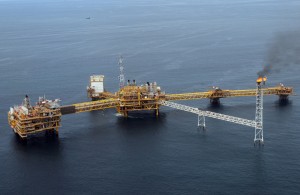 WTI futures were lower during midday trade in Europe today, while Brent added, with renewed violence in Libya threatening the fragile supply outlook increase. Meanwhile, natural gas futures reversed earlier losses, after a massive drop on US weather last week.
WTI futures were lower during midday trade in Europe today, while Brent added, with renewed violence in Libya threatening the fragile supply outlook increase. Meanwhile, natural gas futures reversed earlier losses, after a massive drop on US weather last week.
West Texas Intermediate futures for settlement in August traded for $100.58 per barrel at 13:33 GMT on the New York Mercantile Exchange, down 0.25%. Prices ranged from $100.95 to $100.26 per barrel. The US contract lost about 3% last week.
Meanwhile on the ICE in London, Brent futures due in September stood for a 0.37% gain at $107.66 per barrel. Daily high and low stood at $108.12 and $106.92 per barrel, respectively. Brent’s premium to September WTI stood at $7.58, widening last session’s closing margin of $6.96. The European contract also dropped about 3% last week.
“The supply risks are not gone for good,” Carsten Fritsch, analyst at Commerzbank AG in Frankfurt, said for Bloomberg. “The coming days could see the oil price making a counter movement given that a price fall by almost $10 within three-and-a-half weeks is excessive despite the abating supply risks.”
Libya
Libyan rebels expressed their commitment to reopening the Es Sider port, the country’s biggest oil-exporting facility, the BBC reported. The group also disagreed with a fresh protest, which shut another port in Libya.
“This incident, in the port of Brega, has no impact on the agreement with the government to open Es Sider and Ras Lanuf,” said Ali al-Hasy, a spokesman for the self-declared Executive Office for the Barqa region, cited by Bloomberg. “We stand by the agreement with the government. Es Sider and Ras Lanuf will stay open.”
Meanwhile, fighting erupted at Tripoli’s airport, where rival brigades clashed, resulting in the deaths of at least 7, the BBC reported.
Various gangs and armed groups still control swathes of Libyan territory.
However, the country’s output was at 470 000 barrels per day, a spokesman for the state-run National Oil Corp (NOC) said on Sunday, after averaging 300 000 for the month of June, Reuters reported. Libya holds Africa’s largest crude reserves and has a potential output of some 4 million barrels per day.
US demand
The US Energy Information Administration (EIA) posted its weekly oil inventories report for the seven day through July 4 on Thursday. The log revealed a 2.370 million-barrel draw for commercial crude oil inventories, gasoline inventories added 0.579 million barrels, while distillate fuels stockpiles levels increased by 0.227 million barrels.
Thursday’s “weekly oil inventories showed lower-than-expected gasoline demand,” Michael Poulsen, analyst at Global Risk Management Ltd. in Middelfart, Denmark, said in a report, cited by Bloomberg. It’s “a surprise since the summer driving season is presently peaking.”
Natural gas
Front month natural gas futures, due in August, added 0.24% at the New York Mercantile Exchange to trade for $4.156 per million British thermal units at 13:32 GMT today. Prices ranged from a six-month low of $4.101 to $4.162 per mBtu. The contract dropped 6% last week pressured by moderately cool US weather.
“It looks like the market is going to be in balance heading into the winter,” Michael Lynch, president of Strategic Energy & Economic Research in Winchester, Massachusetts, said for Bloomberg on July 11. “The combination of modest summer weather and robust drilling has let people believe that inventory will grow to normal levels.”
The US Energy Information Administration (EIA) reported on natural gas stockpiles weekly build up last Thursday, to reveal a 93 Billion cubic feet (Bcf) gain for inventories, 21 Bcf more than the 5-year average gain for the week. NatGasWeather.com had predicted an injection of 86-92 Bcf, while a Bloomberg survey had projected 89 Bcf.
NatGasWeather.com suggested an injection of 95-100 Bcf will be reported in this week’s log, about 25 Bcf more than the 5-year average gain for the reported week.
Levels remain 24.4% below readings from last year, but confidence that stockpiles will replenish completely before the start of heating season in November grows.
“The weather’s been mild and traders have been dumping their bullish gas positions,” Phil Flynn, senior market analyst at Price Futures Group in Chicago, said for Bloomberg ahead of the report. “Storage has been growing at a rapid pace week after week.”
Weather outlook
NatGasWeather.com reported on Monday that a cold blast from Canada will be heading south into the US, dragging temperatures down midweek, and reaching as far as Texas. Readings behind the cool front are projected to be some 15-20 degrees Fahrenheit below average at places. The system will also bring many showers and locally heavy rains. The extreme southern and the western US remain in the grips of strong and resilient high pressure, supporting the moderately high temperatures. Later this week, higher pressure will be coming to the Midwest and Northeast as well, normalizing temps after the cool Canadian blast. Cooling demand over the next seven days will probably remain lower than normal.
In the 8-14 day outlook, NatGasWeather.com projected a neutral trend for the US. Higher pressure will be returning to the northeastern half of the US after the cooler Canadian system passes by early in the projected period. However, more blasts will be pushing southwards into the Northeast and Midwest later in the period, probably lowering temps again.





